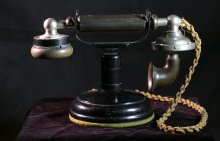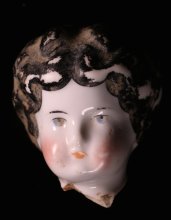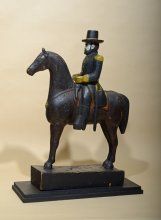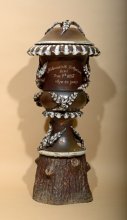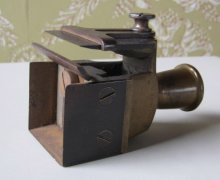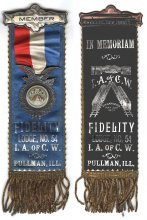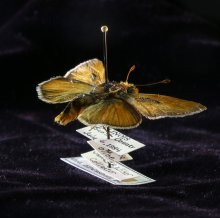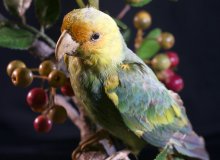Industrializing Illinois (1877-1917)
Following the Civil War, Illinois continued to grow in population, diversity, and complexity. Large-scale heavy manufacturing and a growing commercial sector joined agriculture as major employers of a rapidly growing population. Immigration continued, with African Americans from the South and southern and eastern Europeans joining more established groups. Conflicting interests sometimes led to unrest, strikes, and even violence. During this period, Illinois also became a center of exciting new movements in art, architecture, and literature.
This phone was made by the Kellogg Switchboard & Supply Company of Chicago in 1906. Known as the Microphone 1, this model was the first telephone in the United States to integrate a transmitter and a receiver into a single handset. Between 1900 and 1910, the number of telephones in use in the United States went from 600,000 to 5.8 million.
Like the detailed Staffordshire transfer print plates used for dining, residents on the Illinois frontier also imported other goods from Europe, including toys. This porcelain doll head, along with other pieces, was recovered from a cistern at the Huggins Farmstead Site in Perry County.
Frank P. Richards was a farmer living near Rochester, Illinois, who spent his evenings and winters carving. He quit farming and moved to Edinburg, Illinois, and eventually Springfield, Illinois, where he did odd jobs and became known as an inventor.
The urn harks back to ancient Greek funeral cremation urns. The interest in Greece and Rome—the Neo-Classical Revivals of the 18th and 19th centuries—inspired architecture and decoration that emulated these ancient cultures.
This is a specialty tool used to cut the relief inset for the frame side of a door hinge. It's likely that it originally had a wooden handle.
Beautiful silk ribbon with badge, from a member of the Fidelity Lodge No. 54, I.A. of C. W. (International Association of Car Workers), Pullman, IL.
In the 1800s and early 1900s, before federal protections for all birds were established, egg collecting thrived as a hobby. Collectors bought, sold, and traded eggs with one another. In 1918, the Migratory Bird Treaty Act was established to stop the commercialization of birds, primarily because market hunting for restaurants and to provide feathers for the hat trade was decimating populations. As egg collecting slowly disappeared in the years following, many collectors gave their collections to museums.
The prairie has its own suite of grasses and wildflowers that make it a unique ecosystem. With the habitat comes the associated insects, birds, reptiles, and amphibians adapted to this sometimes harsh, sometimes beautiful environment.
White-tailed Deer (Odocoileus virginianus) were once so rare that in the early 1900s, Illinois State Museum curators had to arrange to get specimens from Wisconsin for exhibit. Unregulated shooting, changes in land use and other factors combined to all but eliminate deer from the state by the turn of the last century.
It’s a story that was disturbingly familiar at the turn of the 20th Century. The Carolina Parakeet once was found in abundance throughout the eastern and Midwestern United States. The parrot with the northern-most distribution, the colorful and noisy Carolina Parakeet was hard to miss when it gathered in large flocks. By the late 19th century it was rare. By the early 20th century it was virtually extinct, with the last known individual dying in captivity in 1918.
Pages






